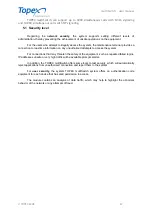
multiSwitch – user manual
© TOPEX 2008 25
4.3.7 Trunks
They are channels where through the calls from other networks are received or sent.
There are two types of routing for trunks: when traffic is sent through IP or through TDM. The options
are:
Routes in / Routes out
– the IN and OUT routes for
TDM traffic
. The parameters are:
•
port
– the switch port (slot)
•
client id
– the id from the clients table
IP Routes IN / IP Routes OUT
– the IN and OUT routes for
IP traffic
. The parameters are:
•
IP
– the IP Address or the IP mask
•
port
– number of the port on which the call is made
•
proto
– the protocol used for sending the call. It can be SIP or H 323
•
clientid
– the id of a client
0
Warning!
For IP traffic, the IP parameter for the “IP Routes OUT” can be only the IP Address and
for “IP Routes IN” it can be the IP Address or the IP / Mask.
4.4 Destinations
After the Client Class and Client identification are made, the next step is the identification of
the destination route. This feature of the TOPEX MultiSwitch shows the way routing is made.
The routing operation is based on several parameters described below:
Client Classes Id
– the identification code from Client Classes
Prefix
– the destination number of the call
Action
– the operation made by the switch depending on the destination number. There are several
actions that can be accomplished:
•
the call can be routed to a subscriber
•
the call can be routed to a Client Class if the destination is an id from the Client Class
•
the call can be routed to a service if the destination is a service number
•
the call can be routed to a hunting group
•
the call can not be routed
•
the call can be routed on LCR if the destination is “
lcr
” from the LCR table
Tax type
– the way how the call is charged. There are several methods for charging calls developed
by the TOPEX MultiSwitch:
•
charging through the taxid pulses
•
charging on time, where taxid is the id on the table “tax on time”
•
charging depending on the geographical areas (labeled from 0 to 9).
Fork
– the number of forked calls to reach the destination.
Mod
– the way the call is routed depending on call parameters. The options are:
•
normal routing
•
it is searched the destination with he best ASR – Answer Seizure Ratio – the number of
successful answered calls divided by the number of all the tries to call
•
it is searched the destination with the best ACD – Average Call Duration
Max connection time
– after this time is out of date the call is dropped.
Max digits
– the maximum number of digits for a destination. It is set to 20. All the digits sent beyond
this number will be ignored.
Digits time out
– this option interfere when the allocated time to dial the digits has expired.















































